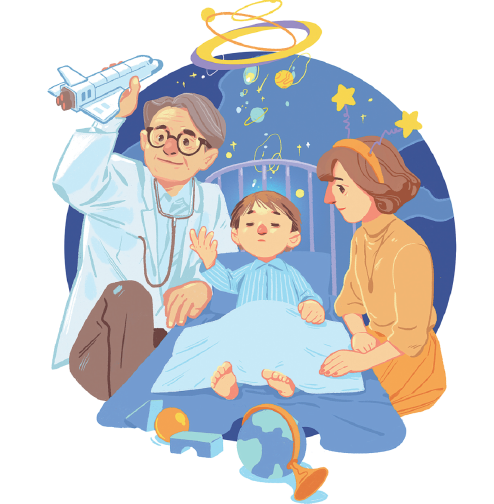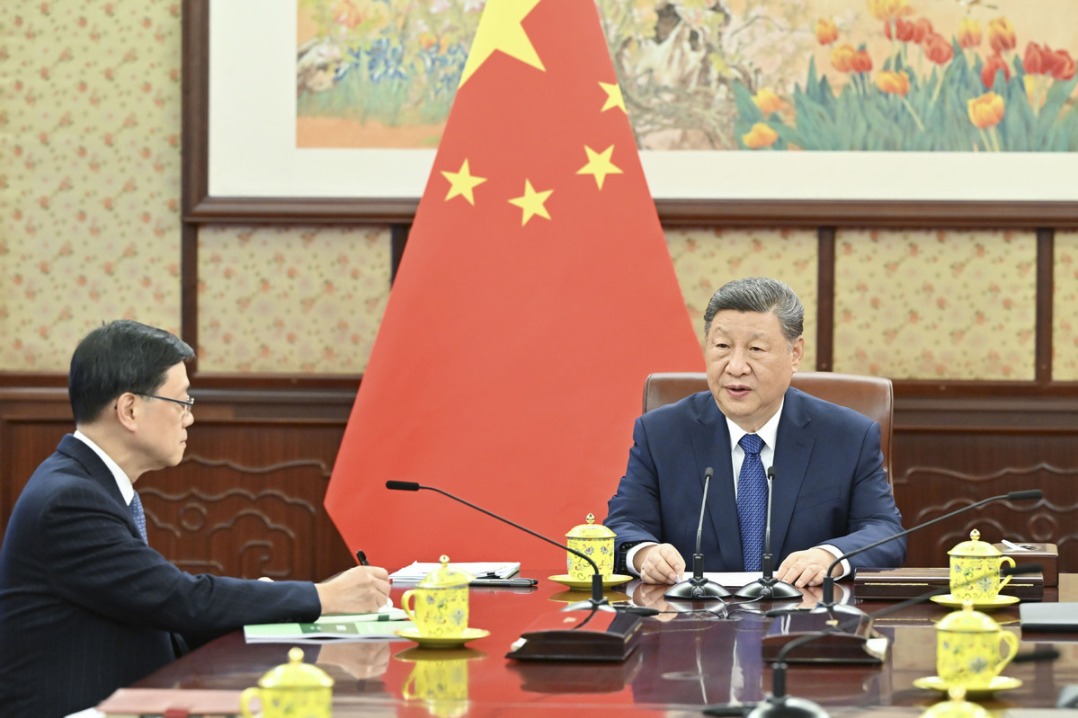Hospice gives children dignity in final days
By Zhang Yangfei | CHINA DAILY | Updated: 2021-12-02 09:27

A charity-funded center in Beijing is providing help for families as the end approaches. Zhang Yangfei reports.
The Daisy House, Beijing's first children's hospice, sits inside China's first end-of-life center, the Songtang Hospice.
However, the children's center looks nothing like its parent building, where white wards line the corridors.
Instead, it looks just like a home. It is well-furnished, with a living room and an open kitchen. The bedrooms are spacious and each has a soft, king-size bed in the middle. The walls are light green and covered with cartoon stickers.
"We call it the Daisy House because we want it to feel like a home. If a child is unable to die in their own home, they should at least be in a place where they can feel safe and loved," said Zhou Xuan, the founder, who is chief physician with the Hematology Oncology Center at Beijing Children's Hospital affiliated to Capital Medical University.
In 2017, Zhou launched the hospice, which is funded by the New Sunshine Charity Foundation and provides palliative care for terminally ill children. Families pay for the services according to the amount of care provided and their personal circumstances.
So far, the hospice has received 106 children from across the country, their ages ranging from a few days old to 14. The majority had hematologic tumors, caused by a form of blood cancer, and the average stay was about two weeks.
Zhou came across the concept of pediatric palliative care at an international conference. "I didn't understand what the term meant, except that it might be one more way to help make our patients' treatment less painful," she said.
In 2013, Zhou visited the St. Jude Children's Research Hospital in Memphis, United States, to observe pediatric palliative care.
During a visit to a ward, she saw a mother sitting in a rocking chair with her baby, who was sleeping soundly with a pacifier.
After talking with the mother and the accompanying professor, Zhou learned that the child was terminally ill and was undergoing palliative care. "I was very, very surprised," she said.
As an oncologist with more than 20 years' clinical experience, Zhou has faced life and death problems every day, and seen many deaths. To her, death has always been a tragic process, with parents crying out their child's name and doctors making a last attempt at resuscitation.
"I had never seen such a death, where a child died peacefully and with dignity," she said.
Initial idea
The visit gave Zhou the idea of providing hospice care for children in China. "I remember looking at the nurse who had accompanied me with the same look as proposing a marriage. I told her, 'I want to do pediatric palliative care, will you do it with me?' She said 'yes'," she recalled.
Zhou and the nurse formed the first palliative care team at the hospital in 2013, but starting from scratch wasn't easy. Without guidance, Zhou read lots of related foreign literature, but the more she read, the more discouraged she became.
She said she recognized all the words, but she couldn't understand them. For example, the books repeatedly mentioned "communication", but didn't specify how or what to communicate.
Zhou decided to use her strengths as a clinician, and also talk with her patients' families to gain a better understanding.
The first parent was the mother of a child who had a solid tumor (one that does not contain fluid). It was evening and the hospital was too noisy to find a quiet place to talk, so the two each carried a small wooden seat and sat at the end of a corridor.
They stared at each other, but neither spoke. "Even as an experienced clinician, I didn't even know how to start the conversation," Zhou said.
Usually when doctors speak with parents, the conversation revolves around encouragement and the chances of a cure for the child. After a long silence, the mother spoke first, asking Zhou what would become of her daughter.
After talking with many parents, Zhou started to understand their concerns, such as being unable to endure seeing their child in great pain or noticing symptoms they did not want to acknowledge. They also wanted to know what state the child would be in when dying, and if he or she would bleed excessively, become disfigured or die in pain.
"I need to explain these possible situations in advance and let them know what I would do to tackle those situations should they occur," she said.
A difficult start
It was difficult for Zhou to establish a separate hospice within a public hospital because space and resources were limited.
After searching, she found that the privately owned Songtang Hospice was ideal because it provides palliative care for adults, therefore it stocks morphine and several other analgesic drugs.
At first, Zhou ran the Daisy House by herself, but now she has an established team with a ward supervisor, social workers and several volunteers. This year, the hospice was expanded from one room to three.
To be admitted, a child must meet two criteria: he or she must be terminally ill, and their parents must acknowledge that there is no cure and that treatment should cease.
Parents book appointments with Zhou, where she assesses the child's state and the parents' views.
"As long as there is a ray of hope, most parents wouldn't give up. You have to respect their choice," she said.
If the parents are ready to stop the treatment and want to send their child to the hospice, Zhou passes them on to the ward supervisor, Cao Ying, who deals with all the details, including registration and the move.
When the appointed day comes, Cao arrives early to provide a warm welcome and a neatly made bed.
To make the stay as much like home as possible, Zhou suggests that the parents and other family members accompany the child throughout the days that remain.
Zhou visits the patients regularly and prescribes medication as required. At first, Songtang could only provide oral morphine, but now Zhou has access to an analgesic pump and other sedatives.
Pain control is a crucial part of palliative care. Zhou said one of the most important lessons she learned from her US visit was "No pain control, no discussion," meaning analgesia is essential to the process.
Family feeling
One of the most recent beneficiaries of Zhou's initiative was a woman surnamed Zhang, whose daughter was diagnosed as having a malignant brain tumor.
In July, Zhang and her husband traveled to Beijing from their home in Jiangsu province to seek help for the girl, who was nicknamed Jingjing.
They had accepted that their child's illness was incurable, but they couldn't bear the sound of her crying all night long.
After arriving in the capital, Zhang posted a message on social media updating Jingjing's status. In response, she received messages recommending the Daisy House.
Zhang said she chose to send the girl to the hospice because she had experienced too much pain while receiving hospital treatment.
"Her father and I were desperate. We couldn't give her relief and we could only watch her suffer," Zhang said, adding that before she came to the hospice, she had no idea what child palliative care was.
After settling in, Jingjing was given analgesic medication and her body relaxed immediately. She unclenched her fists and gradually fell asleep. "I felt so relieved," Zhang said.
Jingjing died just a few days after her second birthday.
Zhang said the hospice workers made her feel at home, as the volunteers cooked for the family and social workers stayed with them the whole time, providing comfort.
"When we first came here, we were very upset and scared. We thought we would probably never want to have another child. The hospice team really helped us face the parting and death, making us feel that death was not that frightening," she said.
"Doctor Zhou is doing a really great job. The shock of losing a child is really too great. She is not just helping a child, though, she is saving a family."
























